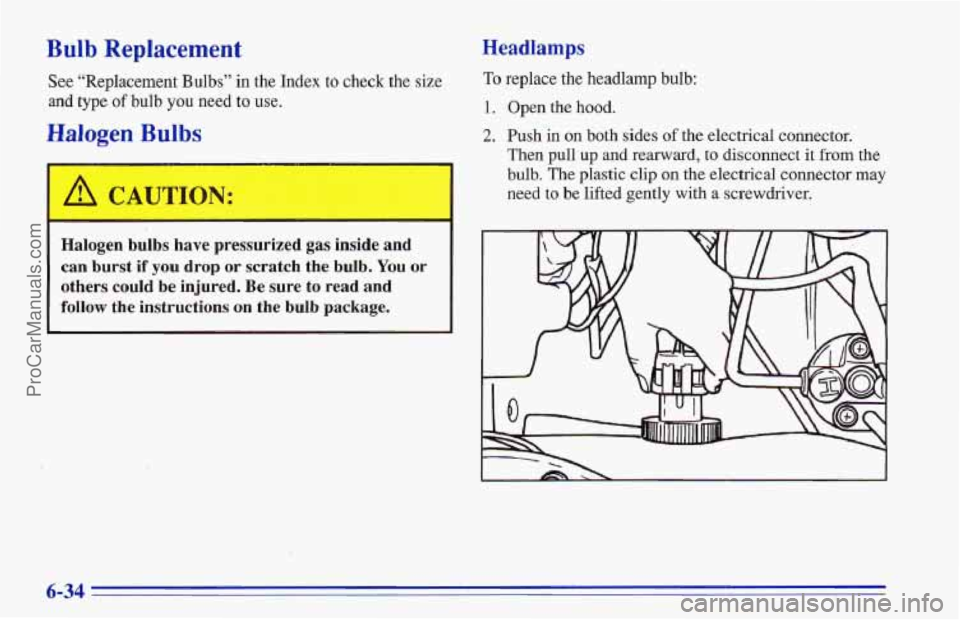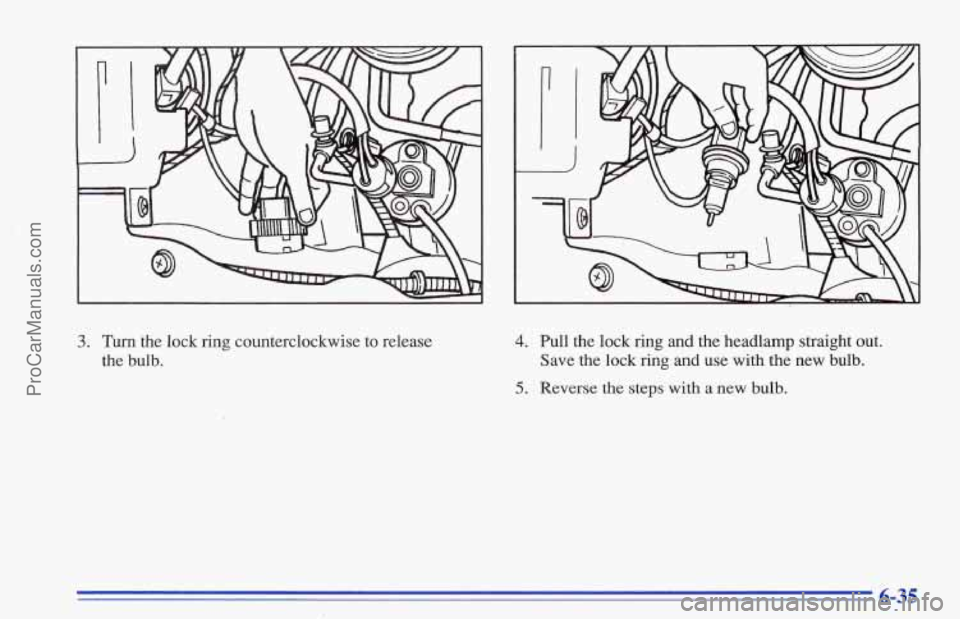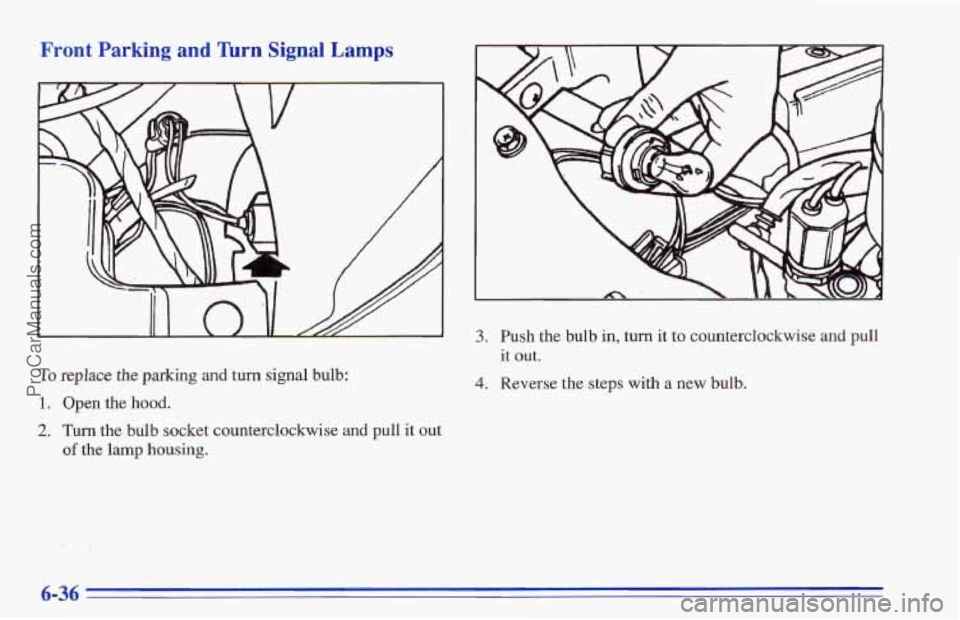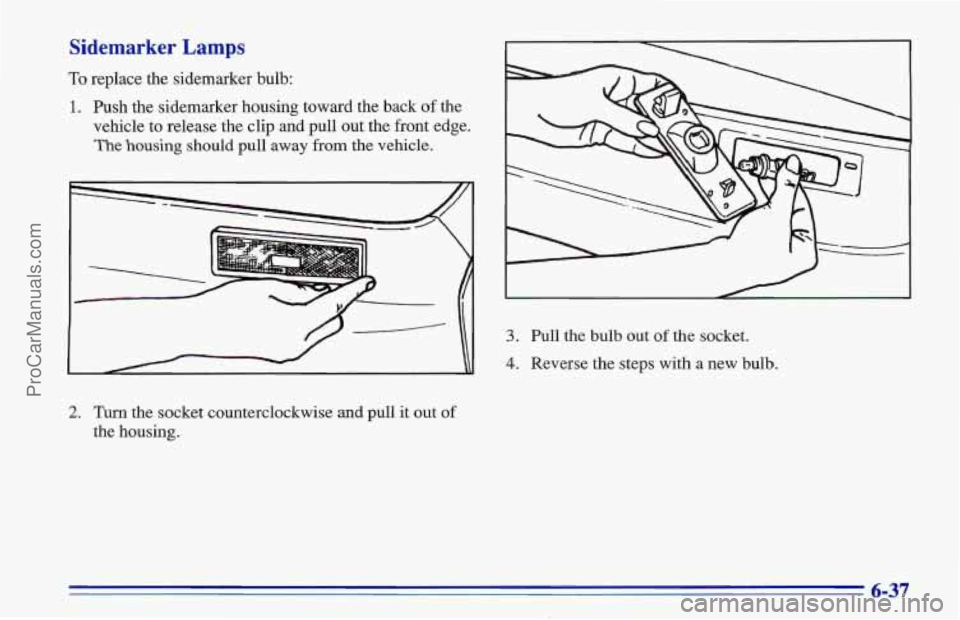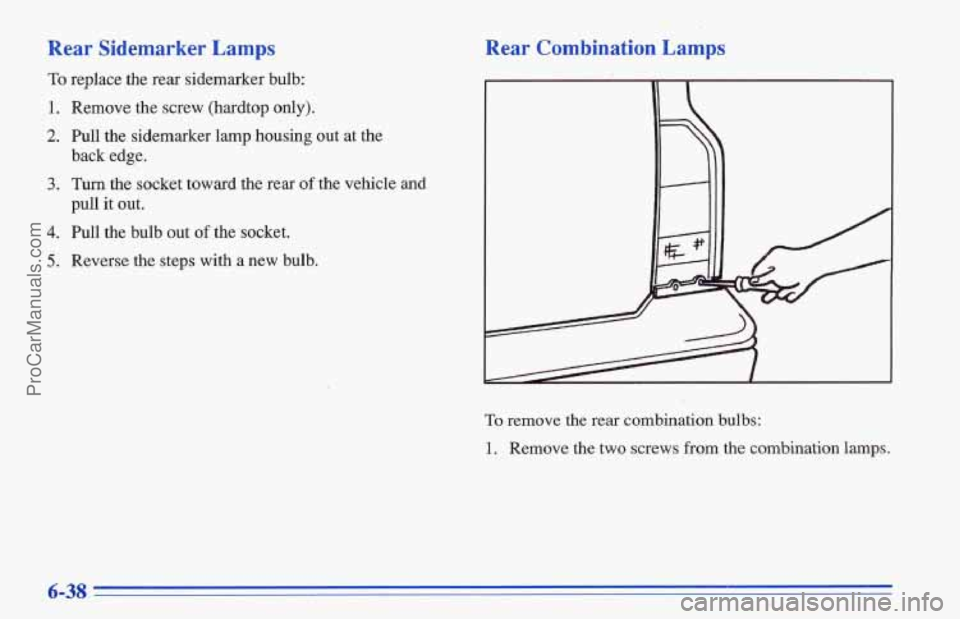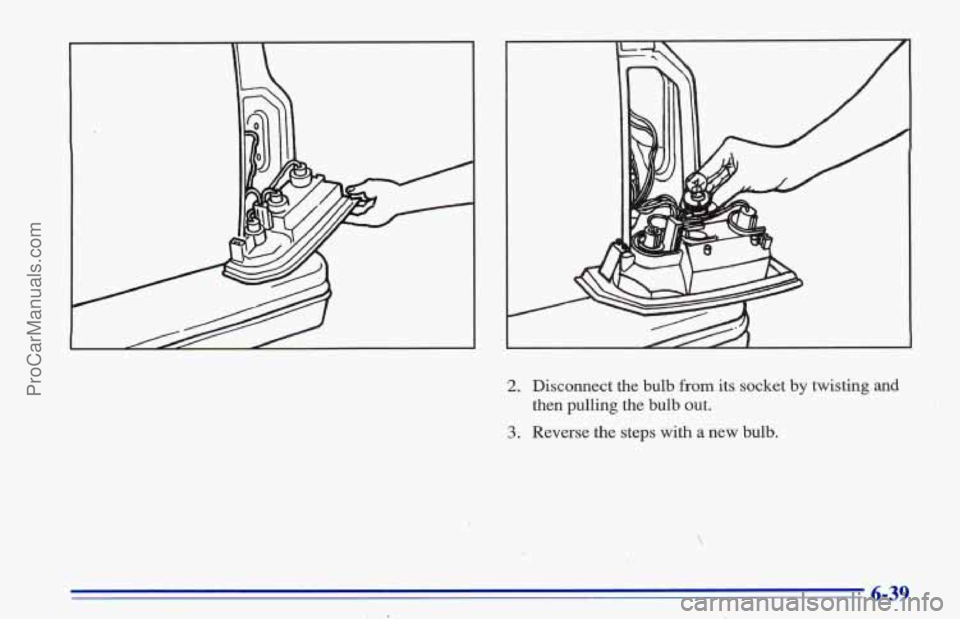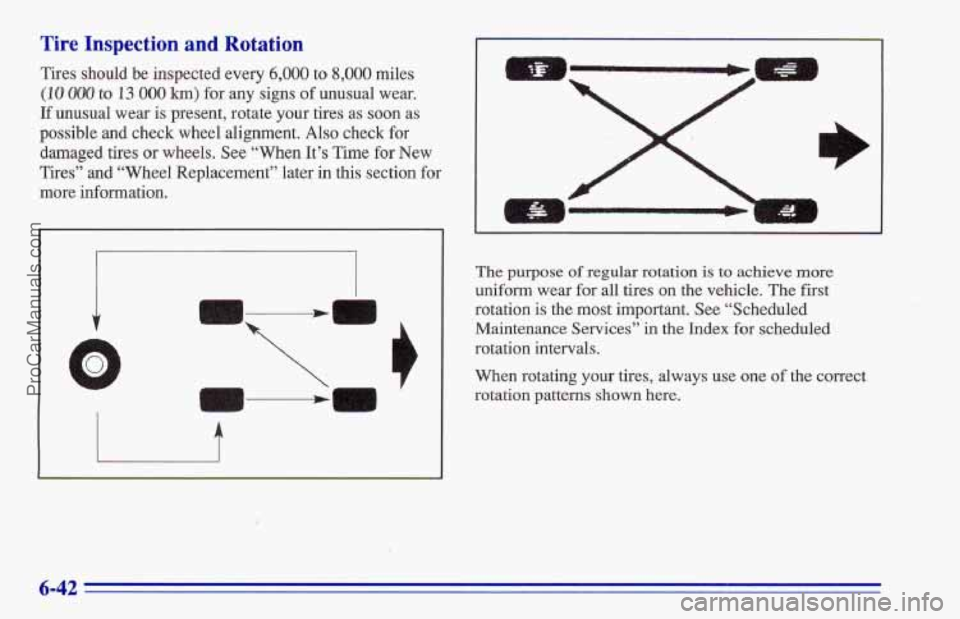CHEVROLET TRACKER 1996 Owners Manual
TRACKER 1996
CHEVROLET
CHEVROLET
https://www.carmanualsonline.info/img/24/57721/w960_57721-0.png
CHEVROLET TRACKER 1996 Owners Manual
Trending: battery replacement, warning light, fuel pressure, fuel fill door release, buttons, heating, wiper blades
Page 271 of 387
Bulb Replacement
See “Replacement Bulbs” in the Index to check the size
and type of bulb you need to use.
Halogen Bulbs
Halogen bulbs have pressurized gas inside and
can burst,if you drop or scratch the bulb. You or
others could
be injured. Be sure to read and
follow the instructions on the bulb package.
Headlamps
To replace the headlamp bulb:
1. Open the hood.
2. Push in on both sides of the electrical connector.
Then
pull up and rearward, to disconnect it from the
bulb. The plastic clip on the electrical connector may
need to be lifted gently with a screwdriver.
I
I
6-34
ProCarManuals.com
Page 272 of 387
3. Turn the lock ring counterclockwise to release
the
bulb.
4. Pull the lock ring and the headlamp straight out.
Save the lock ring and
use with the new bulb.
5. Reverse the steps with a new bulb.
6-35
ProCarManuals.com
Page 273 of 387
Front Parking and Turn Signal Lamps
To replace the parking and turn signal bulb:
1. Open the hood.
2. Turn the bulb socket counterclockwise and pull it out
of the lamp housing.
3. Push the bulb in, turn it to counterclockwise and pull
it out.
4. Reverse the steps with a new bulb.
6-36
ProCarManuals.com
Page 274 of 387
Sidemarker Lamps
To replace the sidemarker bulb:
1. Push the sidemarker housing toward the back of the
vehicle to release the clip and pull out the front edge.
The housing should pull away from the vehicle.
2. Turn the socket counterclockwise and pull it out of
the housing.
3. Pull the bulb out of the socket.
4. Reverse the steps with a new bulb.
6-37
ProCarManuals.com
Page 275 of 387
Rear Sidemarker Lamps
To replace the rear sidemarker bulb:
Rear Combination Lamps
1.
2.
3.
4.
5.
Remove the screw (hardtop only).
Pull the sidemarker lamp housing out at the
back edge.
Turn the socket toward the rear of the vehicle and
pull it out.
Pull the bulb out
of the socket.
Reverse the steps with a new bulb.
To remove the rear combination bulbs:
1. Remove the two screws from the combination lamps.
6-38
ProCarManuals.com
Page 276 of 387
2. Disconnect the bulb from its socket by twisting and
then pulling the bulb out.
3. Reverse the steps with a new bulb.
ProCarManuals.com
Page 277 of 387
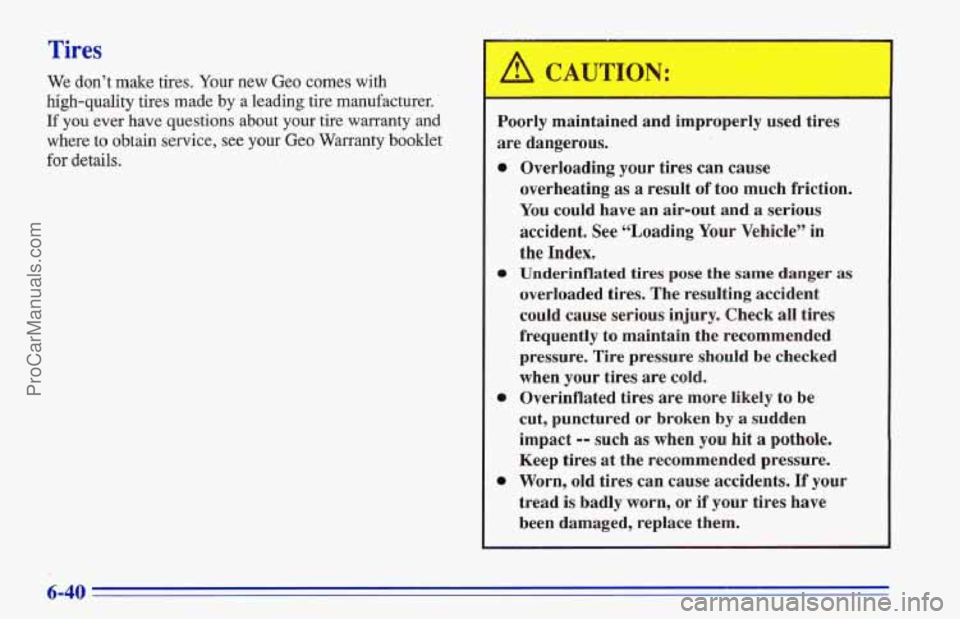
We don’t make tires. Your new Geo comes with
high-quality tires made by a leading tire manufacturer.
If you ever have questions about your tire warranty and
where to obtain service, see your Geo Warranty booklet
for details.
A CAUTION:
Poorly maintained and improperly used
are dangerous.
0 Overloading your tires can cause tires
0
0
0
overheating as a result of too
much friction.
You could have an air-out and a serious
accident. See “Loading
Your Vehicle” in
the Index.
Underinflated tires pose the same danger as
overloaded tires. The resulting accident
could cause serious injury. Check all tires
frequently to maintain the recommended
pressure. Tire pressure should be checked
when your tires are
cold.
Overinflated tires are more likely to be
cut, punctured or broken by a sudden
impact
-- such as when you hit a pothole.
Keep tires at the recommended pressure.
Worn,
old tires can cause accidents. If your
tread
is badly worn, or if your tires have
been damaged, replace them.
6-40
ProCarManuals.com
Page 278 of 387
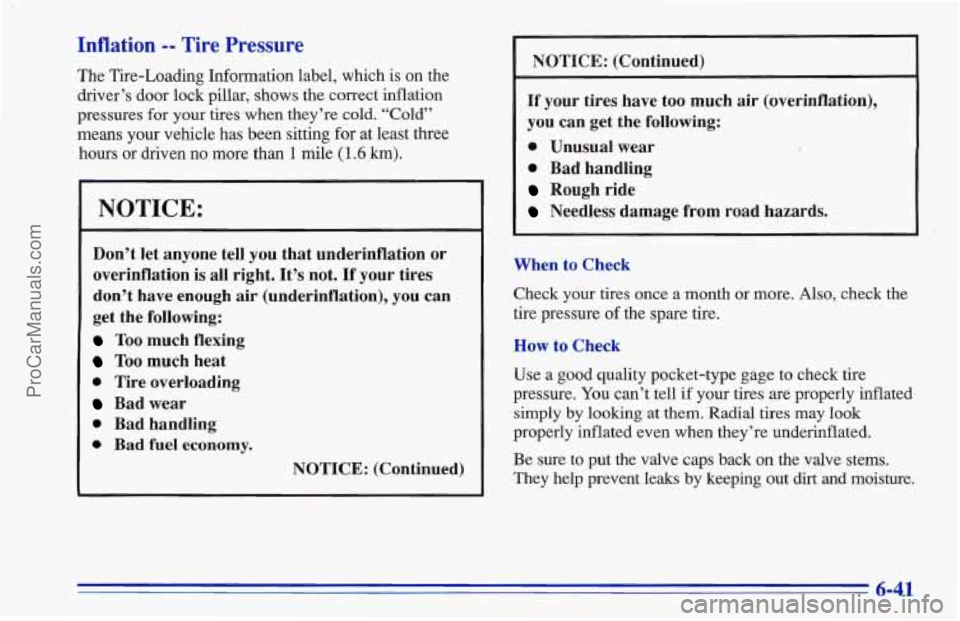
Inflation -- Tire Pressure
The Tire-Loading Information label, which is on the
driver’s door lock pillar,
shows the correct inflation
pressures for your tires when they’re cold. “Cold”
means your vehicle has been sitting for at least three
hours or driven no more than
1 mile ( 1.6 km).
I NOTICE:
Don’t let anyone tell you that underinflation or
overinflation is all right. It’s
not. If your tires
don’t have enough
air (underinflation), you can
get the following:
Too much flexing
Too much heat
0 Tire overloading
Bad wear
0 Bad handling
0 Bad fuel economy.
NOTICE: (Continued) NOTICE:
(Continued)
If your tires have too much air (overinflation),
you can get the following:
0 Unusual wear
0 Bad handling
Rough ride
Needless damage from road hazards.
~
When to Check
Check your tires once a month or more. Also, check the
tire pressure
of the spare tire.
How to Check
I
I
L’
Use a good quality pocket-type gage to check tire
pressure. You can’t tell
if your tires are properly inflated
simply by looking at them. Radial tires may
look
properly inflated even when they’re underinflated.
Be sure to put the valve caps back
on the valve stems.
They help prevent leaks by keeping out
dirt and moisture.
6-41
ProCarManuals.com
Page 279 of 387
Tire Inspection and Rotation
Tires should be inspected every 6,000 to 8,000 miles
(IO OOO ro 13 000 km) for any signs of unusual wear.
If unusual wear is present, rotate your tires as soon as
possible
and check wheel alignment. Also check for
damaged tires
or wheels. See “When It’s Time for New
Tires” and “Wheel Replacement” later in this section for
more information.
m
J
Q
L L
t
The purpose of regular rotation is to achieve more
uniform wear for all tires on the vehicle. The first
rotation is the
most important. See “Scheduled
Maintenance Services” in the Index for schc . [led
rotation intervals.
When rotating
your tires, always use one of the correct
rotation
patterns shown here.
6-42
ProCarManuals.com
Page 280 of 387
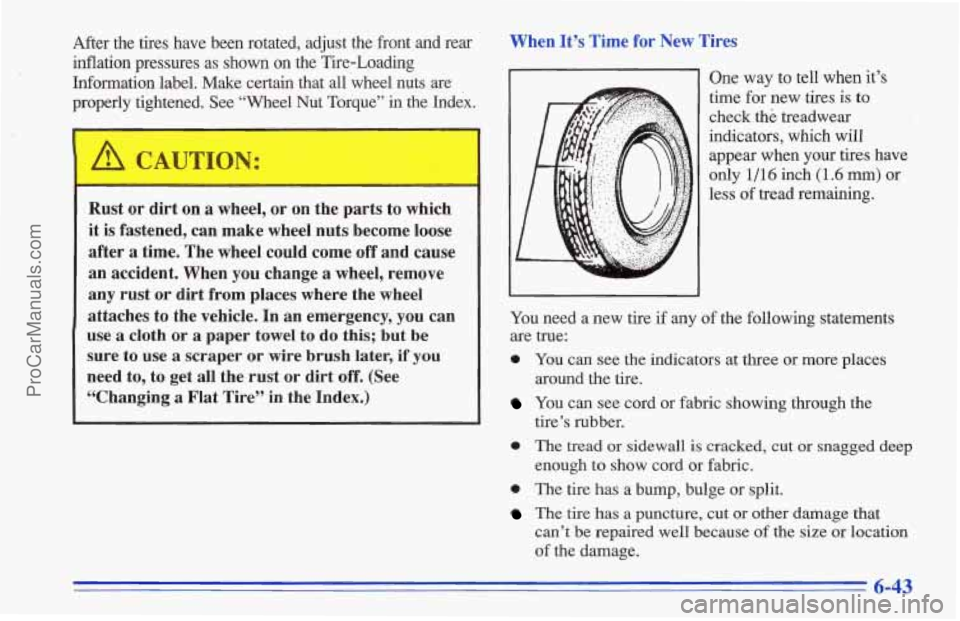
After the tires have been rotated, adjust the front and rear
inflation pressures as shown on the Tire-Loading
Information label. Make certain that all wheel nuts are
properly tightened. See “Wheel Nut Torque”
in the Index.
Rust or dirt on a wheel, or on the parts to which
it is fastened, can make wheel nuts become loose
after a time. The wheel could come off and cause
an accident. When
you change a wheel, remove
any rust or dirt from places where the wheel
attaches to the vehicle. In an emergency, you can
use
a cloth or a paper towel to do this; but be
sure
to use a scraper or wire brush later, if you
need to, to get all the rust or dirt off. (See
“Changing
a Flat Tire” in the Index.) When
It’s Time
for New Tires
One way to tell when it’s
time for new tires
is to
check the treadwear
indicators, which will
appear when your tires have
only
1/16 inch (1.6 mm) or
less of tread remaining.
You need a new tire if any of the following statements
are true:
0 You can see the indicators at three or more places
You can see cord or fabric showing through the
tire’s rubber.
0 The tread or sidewall is cracked, cut or snagged deep
enough to show cord or fabric.
0 The tire has a bump, bulge or split.
The tire has a puncture, cut or other damage that
around the tire.
can’t be repaired well because of the size or location
of the damage.
6-43
ProCarManuals.com
Trending: jump start, towing, boot, timing belt, wheel alignment, winter tires, lane assist
